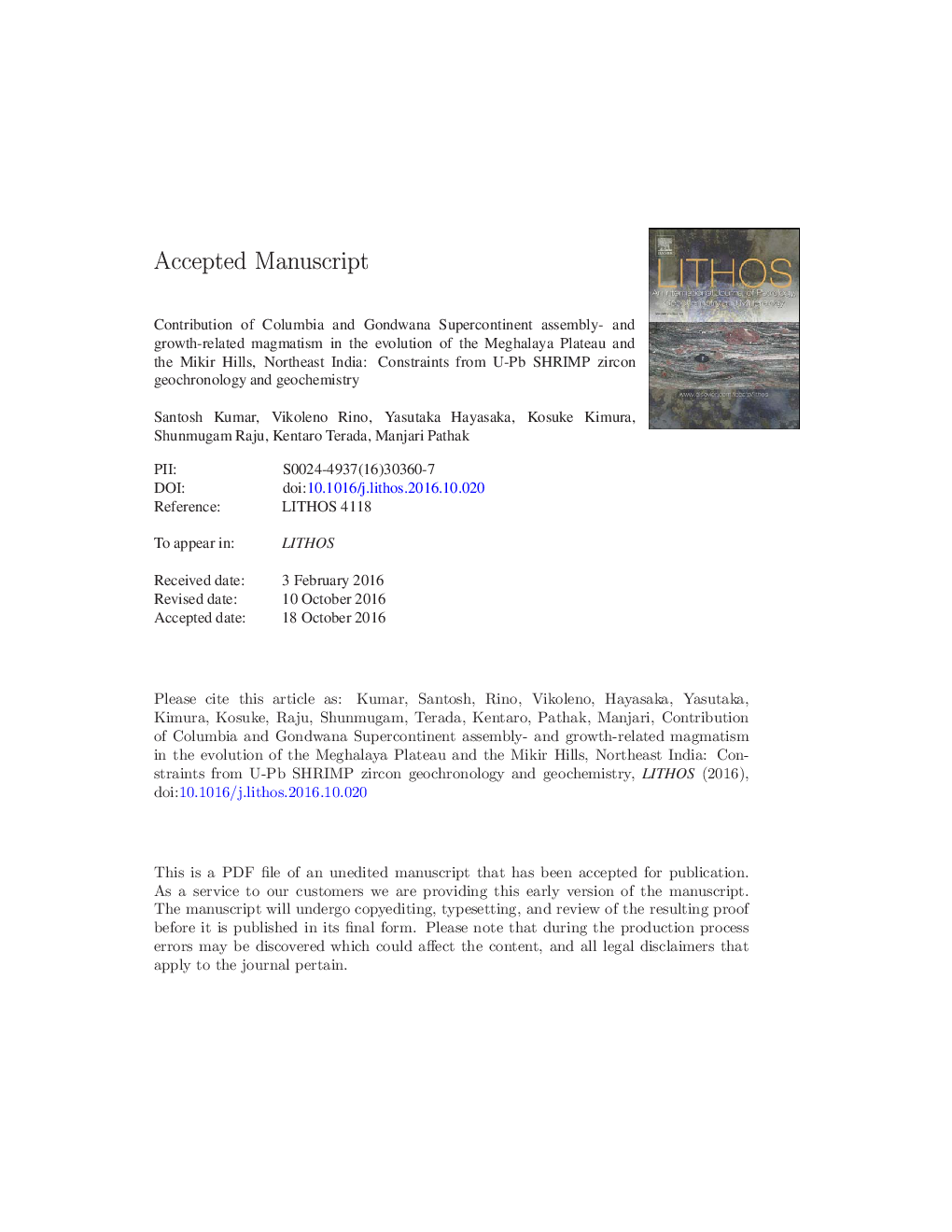| کد مقاله | کد نشریه | سال انتشار | مقاله انگلیسی | نسخه تمام متن |
|---|---|---|---|---|
| 5784097 | 1638633 | 2017 | 61 صفحه PDF | دانلود رایگان |
عنوان انگلیسی مقاله ISI
Contribution of Columbia and Gondwana Supercontinent assembly- and growth-related magmatism in the evolution of the Meghalaya Plateau and the Mikir Hills, Northeast India: Constraints from U-Pb SHRIMP zircon geochronology and geochemistry
دانلود مقاله + سفارش ترجمه
دانلود مقاله ISI انگلیسی
رایگان برای ایرانیان
کلمات کلیدی
موضوعات مرتبط
مهندسی و علوم پایه
علوم زمین و سیارات
ژئوشیمی و پترولوژی
پیش نمایش صفحه اول مقاله

چکیده انگلیسی
The Meghalaya Plateau and the Mikir Hills constitute a northeastern extension of the Precambrian Indian Shield. They are dominantly composed of Proterozoic basement granite gneisses, granites, migmatites, granulites, the Shillong Group metasedimentary cover sequence, and Mesozoic-Tertiary igneous and sedimentary rocks. Medium to coarse grained, equigranular to porphyritic Cambrian granite plutons intrude the basement granite gneisses and the Shillong Group. U-Pb SHRIMP zircon geochronology and geochemistry of the granite gneisses and granites have been carried out in order to understand the nature and timing of granite magmatism, supercontinent cycles, and crustal growth of the Meghalaya Plateau and Mikir Hills. Zircons from the Rongjeng granite gneiss record the oldest magmatism at 1778 ± 37 Ma. An inherited zircon core has an age of 2566.4 ± 26.9 Ma, indicating the presence of recycled Neoarchaean crust in the basement granite gneisses. Zircons from the Sonsak granite have two ages: 523.4 ± 7.9 Ma and 1620.8 ± 9.2 Ma, which indicate partial assimilation of an older granite gneiss by a younger granite melt. Zircons from the Longavalli granite gneiss of the Mikir Hills has a crystallization age of 1430.4 ± 9.6 Ma and a metamorphic age of 514 ± 18.6 Ma. An inherited core of a zircon from Longavalli granite gneiss has an age of 1617.1 ± 14.5 Ma. Zircons from younger granite plutons have Cambrian mean ages of 528.7 ± 5.5 Ma (Kaziranga), 516 ± 9.0 Ma (South Khasi), 512.5 ± 8.7 Ma (Kyrdem), and 506.7 ± 7.1 Ma and 535 ± 11 Ma (Nongpoh). These plutons are products of the global Pan-African tectonothermal event, and their formation markedly coincides with the later stages of East Gondwana assembly (570-500 Ma, Kuunga orogen). The older inherited zircon cores (2566.4 ± 26.9 Ma, 1758.1 ± 54.3 Ma, 1617.1 ± 14 Ma) imply a significant role for recycled ancient crust in the generation of Cambrian granites. Thus the Meghalaya Plateau and Mikir Hills experienced major felsic magmatic episodes at ~ 1800 Ma, ~ 1600 Ma, ~ 1400 Ma, and ~ 500 Ma with recycling of Neoarchaean crust, and later contributions from Paleo-Mesoproterozoic granite gneiss sources. A 258 ± 20 Ma lower intercept age of the Rongjeng granite gneiss perhaps indicates a Permo-Triassic thermal imprint on the Meghalaya Plateau. The granite gneisses and granites have peraluminous to metaluminous compositions, and syn-orogenic to post-collisional affinities. We conclude that the orogenic history of the Meghalaya Plateau and the Mikir Hills records crustal growth of the Columbia and Gondwana supercontinents as noted in other Pan-African-Indian-Prydz-Brasiliano orogens.
ناشر
Database: Elsevier - ScienceDirect (ساینس دایرکت)
Journal: Lithos - Volume 277, 15 April 2017, Pages 356-375
Journal: Lithos - Volume 277, 15 April 2017, Pages 356-375
نویسندگان
Santosh Kumar, Vikoleno Rino, Yasutaka Hayasaka, Kosuke Kimura, Shunmugam Raju, Kentaro Terada, Manjari Pathak,